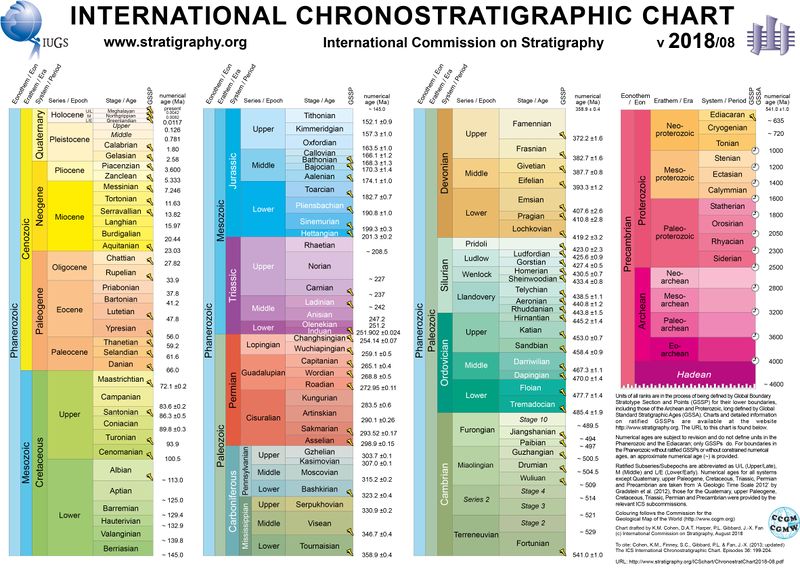Triassic
The Triassic was the first geological period of the Mesozoic era, extending from approximately 251.902 million to 201.3 million years ago. It is divided into Upper, Middle, and Lower epochs (Figure 1).[1] The name "Triassic" is derived from German geologist Frederich August von Alberti's Trias (1834), which united three rock formations: coloured sandstone (Figure 2), clam limestone, and non-marine red beds.[2]
The Triassic began and ended with major extinction events. The early Triassic saw plants and animals slowly recovering from the Permian-Triassic extinction event. The late Triassic saw the first true dinosaurs (Figure 3) dominating on land and marks the beginning of the "Age of Dinosaurs" (the Mesozoic era). Other animals also existed (Figure 4), including the first mammals (Figure 5) and flying vertebrates.[2] Regional climates and paleogeographic areas became more distinct, with deserts, grasslands, and different types of forests developing. Wetter regions produced coal-rich formations that exist today.[5] The Triassic ended with the Triassic-Jurassic extinction event, wiping out entire classes of marine species and many of the large amphibians that existed on land.[2]
-
Figure 3. Coelophysis, one of the first dinosaurs.[6]
-
Figure 4. Lystrosaurus, a common land vertebrate.[7]
-
Figure 5. Cynognathus was a mammal-like cynodont.[8]
The Pangea supercontinent experienced a relatively hot and arid climate during this period. No evidence has been found of the glaciations that routinely occurred in earlier periods.[2] By the Middle Triassic, Pangea began to drift apart, breaking into the continents of southern Gondwana and northern Laurasia. The breaking up of Pangea allowed for the drier inner areas of the landmass to experience more humidity.[5] The breaking up Pangea and the resulting change in regional climates, combined with periodic volcanism that was occurring at the time, are thought to be contributing causes to the Triassic-Jurassic extinction event.[2]

For Further Reading
- Geologic time scale
- Geologic period
- Mass extinction
- Supercontinent
- Stratigraphy
- Or explore a random page
References
- ↑ 1.0 1.1 International Commission on Stratigraphy."International Chronostratigraphic Chart v2018" Accessed Nov.8, 2018 [Online]. Available: http://www.stratigraphy.org/index.php/ics-chart-timescale
- ↑ 2.0 2.1 2.2 2.3 2.4 Gradstein, F. M. "The Geologic Time Scale 2012". Volume 2. 1st ed. Amsterdam ; Boston: Elsevier, 2012.
- ↑ International Commission on Stratigraphy."International Chronostratigraphic Chart v2016" Accessed Nov.18, 2012 [Online]. Available: https://www.britannica.com/science/Tithonian-Stage
- ↑ WikiMedia Commons. "File:Stadtroda Sandstein.jpg" Accessed Nov.18, 2018 [Online]. Available: https://en.wikipedia.org/wiki/File:Stadtroda_Sandstein.jpg
- ↑ 5.0 5.1 University of California, Museum of Paleontology."The Triassic Period" Accessed Nov.18, 2018 [Online]. Available: http://www.ucmp.berkeley.edu/mesozoic/triassic/triassic.php
- ↑ WikiMedia Commons. "File:Coelophysis size flipped.jpg" Accessed Nov.18, 2018 [Online]. Available: https://en.wikipedia.org/wiki/File:Coelophysis_size_flipped.jpg
- ↑ WikiMedia Commons. "File:Lystrosaurus BW.jpg" Accessed Nov.18, 2018 [Online]. Available: https://en.wikipedia.org/wiki/File:Lystrosaurus_BW.jpg
- ↑ WikiMedia Commons. "File:Cynognathus BW.jpg" Accessed Nov.18, 2018 [Online]. Available: https://en.wikipedia.org/wiki/File:Cynognathus_BW.jpg


![Figure 1.ICS Triassic timeline.[3]](/wiki/images/f/f0/ICS_Triassic.jpg)
![Figure 2. Triassic sandstone near Stadtroda, Germany.[4]](/wiki/images/thumb/e/ec/Stadtroda_Sandstein.jpg/600px-Stadtroda_Sandstein.jpg)
![Figure 3. Coelophysis, one of the first dinosaurs.[6]](/wiki/images/thumb/3/37/Coelophysis_size_flipped.jpg/438px-Coelophysis_size_flipped.jpg)
![Figure 4. Lystrosaurus, a common land vertebrate.[7]](/wiki/images/thumb/1/17/Lystrosaurus_BW.jpg/293px-Lystrosaurus_BW.jpg)
![Figure 5. Cynognathus was a mammal-like cynodont.[8]](/wiki/images/thumb/f/fd/Cynognathus_BW.jpg/336px-Cynognathus_BW.jpg)